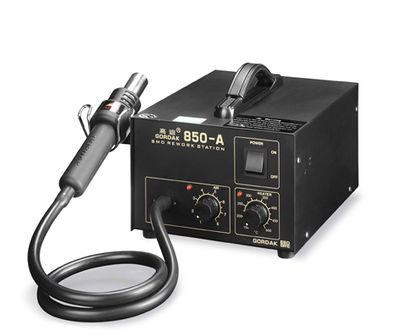Determining Argon hardware failure
If Argon (servo drive) refuses to operate in any meaningful way, it is good to perform few tests for the hardware to identify possible hardware failures.
Contents
Verifying AC to HV DC circuity[edit | edit source]
See Argon supply voltage troubleshooting
Testing power stage[edit | edit source]
Motor power stage and braking resistor output consists IGBT transistors that typically short circuit if they are damaged. Testing of such failure needs only a multimeter with resistance measurement function.
- Unplug all connectors from the drive at least 30 minutes before testing as residue voltages may disturb this test and pose a danger. After 30 minutes fully disconnected, ensure that voltage has been safely discharged.
- Measure resistance between J4 pin VN against BR,U,V and W. A typical resistance is between 100 kΩ - 10 MΩ. If resistance is less than 10 kΩ, there may be a failed IGBT.
- Measure resistance between J4 pin VP against BR,U,V and W. A typical resistance is between 100 kΩ - 10 MΩ. If resistance is less than 10 kΩ, there may be a failed IGBT.
Testing regenerative drive transistor[edit | edit source]
Use this method to test regenerative drive transistor (which burn if regenerative resistor resistance is too low, or it has a wiring short circuit):
- Measure resistance between BR and VN terminals when drive is off and all connectors have been unplugged. If resistance is below 10 kΩ, the regenerative drive transistor damaged.
| This failure will also probably cause the fault where drive HV DC supply voltage does not rise when powered-on. For more details, see Argon supply voltage troubleshooting. |
SimpleMotion V2 port[edit | edit source]
SimpleMotion V2 port (J2 on argon) is protected by clamping diode (type NXP PESD5V0S4UD) that is identified as D19 in the adapter and Argon drive. That diode typically burns if 24VDC is miswired in the port or if faulty Ethernet/RJ45 cable is being used. Same diode exists also in the SimpleMotion V2 USB adapter and may be damaged as well. Sometimes fault propagates longer and kills also RS485 driver chip (Texas Instruments SN65176BDR) which is identified as IC4 on Argon and IC1 on SM V2 USB Adapter.Typical symptom of failure is inability to connect drive through SimpleMotion bus (i.e. Granity does not connect). Sometimes D19 short circuits 5V bus to ground making devices appear completely dead. To test if the device still has life, removing D19 (and possibly IC1 or IC4) can be used to verify whether lights come on when voltage is applied to the device.
The parts mentioned here on Argon and SMV2USB may be replaced by person capable of desoldering and soldering SMT components.
Testing the failure[edit | edit source]
Typically D19 short circuits to GND when it has been damaged. To test whether this is the case, measure resistance with multimeter between GND and RS485_A / RS485_B pins of RJ45 connector. If resistance is low (less than 10 Ohms), the D19 is shorted and should be replaced.
Replacing components to repair communication faulure[edit | edit source]
Replacing surface mount components like D19 or IC4 are most conviently done with hot air soldering station.
Typical repair procedure
- First eliminate the original wiring error to prevent same mistake again
- Remove D19
- Try drive communication (just 24V supplied and RJ45 wired straight to SMV2USB).
- If device works, solder a new D19 in place. Job done.
- If no luck, try with known-good or new SMV2USB as well.
- If still no connection is possible, replace also IC4, and try again.
If still no connection (after new D19, IC4 and SMV2USB), then failure might have propagated further making repair more challenging. Granite Devices may be still able to repair it cost efficiently.
| As D19 is a protection device, drive works without it as well, so it is possible to repair the drive just by removing D19. However without the diode, rest of the electronics inside drive are vulnerable to the same error that caused D19 to burn. Operating without D19 will always terminate warranty. |
In no event the Product Information or parts hereof shall be regarded as guarantee of conditions or characteristics. The Product Information or any part thereof may also not be regarded as a warranty of any kind. No liability of any kind shall be assumed by Author with respect to Product Information or any use made by you thereof, nor shall Author indemnify you against or be liable for any third party claims with respect to such information or any use thereof.
As content of this Wiki may be edited by user community, Granite Devices Oy or it's affiliates do not take any responsibility of the contents of this Wiki. Use information at your own risk. However, Granite Devices staff attempts to review all changes made to this Wiki and keep information trustworthy.
Without written consent, Granite Devices' Products or Intellectual Property shall not be used in situations or installations where living beings, material property, or immaterial property could be harmed by the operation, features or failures of Product. Products may only be used in a way where hazards like moving parts, electric shock, laser radiation, or fire can't be realized even if the content of this Wiki would suggest otherwise.

